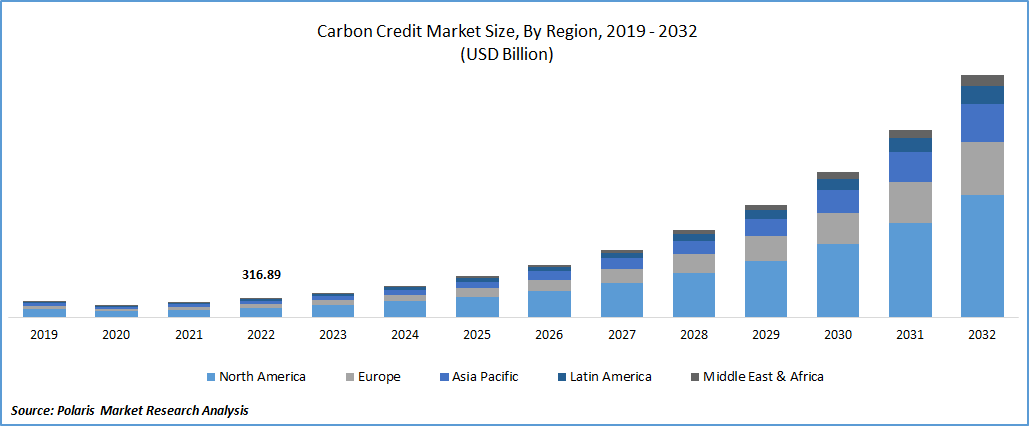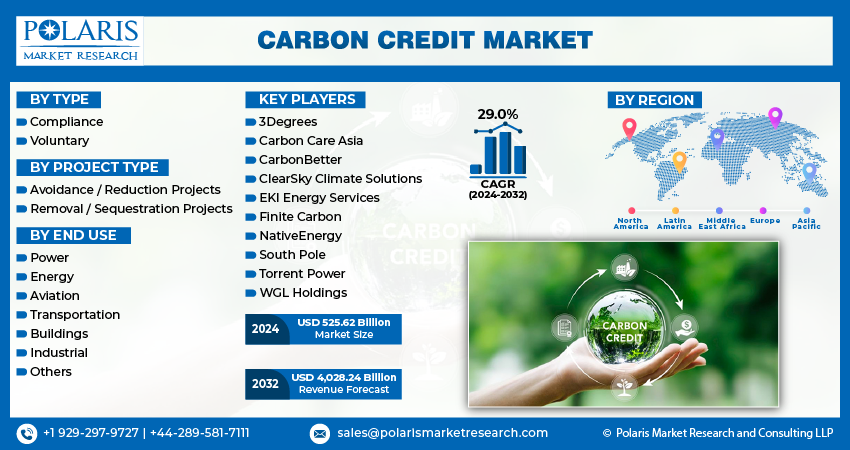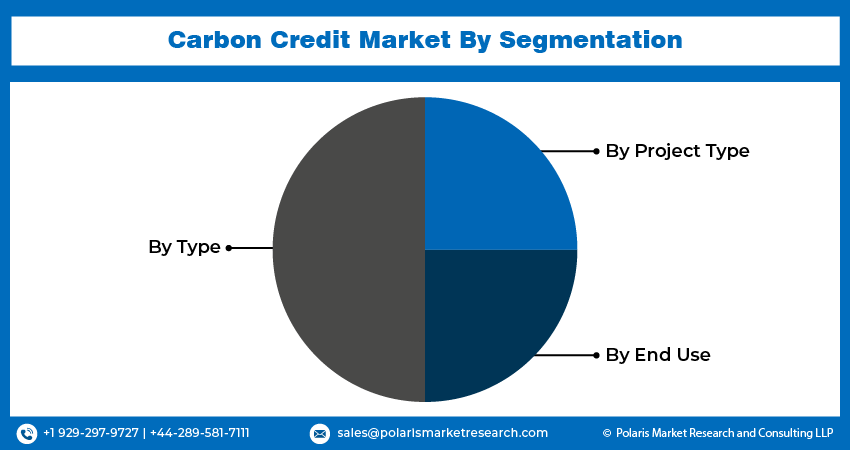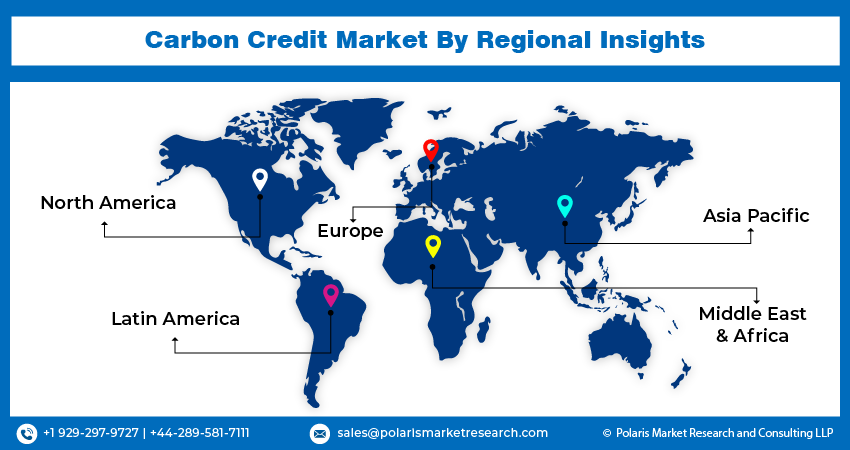
Carbon Credit Market Share, Size, Trends, Industry Analysis Report,
By Type (Compliance, Voluntary), By Project Type (Avoidance/Reduction Projects, Removal/Sequestration Projects), By End-use, By Region, And Segment Forecasts, 2024-2032
- Published Date:Jan-2024
- Pages: 118
- Format: PDF
- Report ID: PM3570
- Base Year: 2023
- Historical Data: 2019-2022
Report Outlook
The global carbon credit market was valued at USD 408.05 billion in 2023 and is expected to grow at a CAGR of 29.00% during the forecast period. Carbon credits are a tool that allows organizations to offset their carbon emissions by purchasing credits from projects that reduce greenhouse gas emissions. These projects can involve renewable energy generation, reforestation, energy efficiency initiatives, and more. By buying carbon credits, companies can offset a portion of their emissions and contribute to the overall reduction of greenhouse gases. Favorable government policies and regulations aim to reduce emissions, and many countries have committed to the Paris Agreement, which sets targets for reducing greenhouse gas emissions. Carbon credits can help companies meet their obligations under these agreements.
Carbon credits also referred to as carbon allowances, are essentially permission slips that allow companies to generate a certain amount of carbon dioxide or other greenhouse gases. With one carbon credit, the owner can release one ton of carbon dioxide or other greenhouse gases. Based on the cap-and-trade model of the 1990s, carbon credits were devised as a mechanism to reduce greenhouse gas emissions. These credits aren’t the same as carbon offsets and only exist in markets with cap and trade regulations.
Companies that pollute get a set number of credits that allow them to continue to pollute up to a certain limit. These credits are then gradually reduced over time. Meanwhile, organizations may sell their unneeded credits to other companies that need them. As such, they create monetary incentives for firms to companies to reduce carbon emissions. Organizations that can’t reduce their greenhouse gas emissions are still allowed to operate, at a higher financial cost. With the rising implementation of governmental policies and regulations to reduce greenhouse gas emissions, the carbon credit market is anticipated to witness robust growth over the forecast period.

To Understand More About this Research: Request a Free Sample Report
Many companies recognize the importance of sustainability and reducing their carbon footprint as part of their corporate social responsibility (CSR) initiatives. Environmental sustainability is crucial not only for mitigating climate change but also for maintaining their social license to operate and meeting stakeholder expectations. As a result, companies are actively seeking ways to reduce their greenhouse gas emissions and demonstrate their commitment to sustainable practices. Carbon credits provide a means for companies to offset their emissions and take responsibility for their environmental impact. The growing concern about climate change and its potential impacts has prompted increased awareness and a sense of responsibility across various sectors, resulting in a higher demand for carbon credits as a tool to offset emissions and contribute to global emission reduction efforts.
Demand for carbon credits in the country is driven by state-level programs and voluntary markets. Several states in the U.S. have implemented cap-and-trade programs, which set a limit on the total amount of greenhouse gas emissions allowed within the state. Companies that exceed their allocated emission allowances are required to purchase carbon credits, also known as allowances or offsets, to offset their excess emissions. The revenue generated from the sale of these allowances is often reinvested in clean energy projects or used to support climate mitigation efforts.
Price volatility of carbon credits poses challenges for companies that rely on stable prices to plan and invest in emission reduction projects. Volatility can make it difficult to assess the financial viability and return on investment for such projects. To mitigate this risk, companies may employ strategies such as forward contracts, hedging mechanisms, or long-term purchasing agreements to manage their exposure to price fluctuations. Efforts are also underway to address price volatility and increase market stability. These include measures like market reforms, improved transparency, standardization of offset quality, and the development of price stabilization mechanisms. Regulatory frameworks and institutions are being established to monitor and manage carbon credit markets more effectively, with the aim of reducing price volatility and ensuring the long-term effectiveness of carbon pricing mechanisms.
The market research report offers an in-depth analysis of the industry to support informed decision-making. It offers a meticulous breakdown of various market niches and keeps readers updated on the latest industry developments. Along with tracking the carbon credit market on the basis of SWOT and Porter’s Five Forces models, the research report includes graphs, tables, charts, and other pictorial representations to help readers understand the key insights and important data easily.
Industry Dynamics
Growth Drivers
Governments are increasingly implementing policies and regulations to reduce greenhouse gas emissions and mitigate climate change worldwide. One common approach is to set targets for emissions reductions and establish regulatory frameworks that require companies to take action to offset their emissions. These regulations often include mechanisms that incentivize or need companies to purchase carbon credits to offset their emissions. Carbon credits represent a reduction or removal of greenhouse gas emissions independently verified and certified according to recognized standards. By purchasing carbon credits, companies can effectively neutralize a portion of their emissions by supporting projects that result in emissions reductions or sustainable practices.

Report Segmentation
The market is primarily segmented based on types, project type, end-use, and region.
|
By Type |
By Project Type |
By End Use |
By Region |
|
|
|
|
To Understand the Scope of this Report: Speak to Analyst
Compliance Segment Accounted for the Largest Market Share in 2022
The compliance segment accounted for the largest carbon credit market share. It consists of companies and organizations subject to government regulations or specific authorities that mandate offsetting their carbon emissions. These regulations set emissions reduction targets or limits and require companies to purchase carbon credits to compensate for their excess emissions. The purchased carbon credits represent verified emission reductions from approved projects, such as renewable energy installations, energy efficiency initiatives, or other eligible activities.
Avoidance/Reduction Segment Garnered the Largest Revenue Share in 2022
The avoidance segment held the largest revenue share in 2022. Renewable energy projects, such as wind farms, solar power installations, or hydroelectric plants, generate carbon credits by avoiding or displacing emissions that would have occurred if the electricity had been generated from fossil fuel sources like coal-fired power plants. The avoided emissions are calculated based on the difference in greenhouse gas emissions between the renewable energy project and the baseline scenario, representing the emissions that would have occurred without the renewable energy project.
Methane capture facilities are another type of avoidance/reduction project. Methane is a potent greenhouse gas emitted during the production and transportation of coal, oil, and natural gas, as well as from landfills and agricultural activities. It involves capturing and utilizing or destroying methane emissions that would otherwise be released into the atmosphere. These projects can include methane recovery from coal mines, methane capture from livestock operations, or methane capture from waste management facilities. The carbon credits generated from methane capture projects represent the avoided emissions that would have occurred if the methane had been released into the atmosphere.

Europe Region Dominated the Global Market in 2022
Europe region dominated the global market with considerable market share. The dominance of the European market in terms of revenue can be attributed to the long-standing presence and maturity of the EU ETS, as well as the comprehensive coverage of installations across many European countries. The EU ETS has successfully established a robust carbon market infrastructure, promoted emissions trading, and encouraged a transition to a low-carbon economy.
Under the EU ETS, a cap is set on the total greenhouse gas emissions allowed from covered installations. Each installation is allocated a certain number of allowances, representing the right to emit a specified amount of greenhouse gases. If a facility exceeds its allocated budget, it must purchase additional subsidies or carbon credits from the market to cover its excess emissions. Conversely, if an installation reduces emissions below the allocated allowances, it can sell surplus allowances or credits.
North America registered a robust growth rate. Price volatility can create opportunities for companies to enter the market and engage in emissions trading, as well as for investors looking for potential returns in the carbon market. This volatility, combined with the potential for market-based incentives and the desire to meet emissions reduction targets, has attracted interest and contributed to the popularity of carbon credits. Governments and authorities have implemented regulatory frameworks and emissions reduction targets that create a demand for carbon credits, driving the development of renewable energy projects and encouraging companies to offset their emissions by purchasing credits.

Competitive Insight
Market can be characterized as moderately fragmented, with various participants involved in research and development (R&D) and technological innovations. This fragmentation is driven by the diverse range of entities and stakeholders engaged in carbon credit activities, including project developers, verification and certification bodies, brokers, financial institutions, and technology providers. R&D plays a crucial role in the carbon credit market as participants continuously seek innovative solutions and technologies to reduce greenhouse gas emissions and enhance the effectiveness of emissions reduction projects. This includes advancements in renewable energy technologies, energy efficiency measures, carbon capture and storage, and other emission reduction initiatives.
Some of the major players operating in the global market include 3Degrees, Carbon Care Asia, CarbonBetter, ClearSky Climate Solutions, EKI Energy Services, Finite Carbon, NativeEnergy, South Pole, Torrent Power, and WGL Holdings.
Recent Developments
In March 2023, Integrity Council for Voluntary Carbon introduced a new “Core Carbon Principles and Program-level Assessment Framework” for carbon credits. This was to set up a threshold for carbon emissions for sustainable development.
Carbon Credit Market Report Scope
|
Report Attributes |
Details |
|
Market size value in 2024 |
USD 525.62 billion |
|
Revenue Forecast in 2032 |
USD 4,028.24 billion |
|
CAGR |
29.0% from 2024 – 2032 |
|
Base year |
2023 |
|
Historical data |
2019 – 2022 |
|
Forecast period |
2024 – 2032 |
|
Quantitative units |
Revenue in USD billion and CAGR from 2024 to 2032 |
|
Segments Covered |
By Type, By Project Type, By End Use, By Region |
|
Regional scope |
North America, Europe, Asia Pacific, Latin America, Middle East & Africa |
|
Key Companies |
3Degrees, Carbon Care Asia, CarbonBetter, ClearSky Climate Solutions, EKI Energy Services, Finite Carbon, NativeEnergy, South Pole, Torrent Power, and WGL Holdings. |
Explore the landscape of carbon credit in 2024 through detailed market share, size, and revenue growth rate statistics meticulously organized by Polaris Market Research Industry Reports. This expansive analysis goes beyond the present, offering a forward-looking market forecast till 2032, coupled with a perceptive historical overview. Immerse yourself in the depth of this industry analysis by acquiring a complimentary PDF download of the sample report.
Browse Our Top Selling Reports
Floral Tea Market Size, Share 2024 Research Report
Gamma Decalactone Market Size, Share 2024 Research Report
Masterbatch Market Size, Share 2024 Research Report
Space Sensors Market Size, Share 2024 Research Report
Pilot Training Market Size, Share 2024 Research Report
FAQ's
key companies in carbon credit market are 3Degrees, Carbon Care Asia, CarbonBetter, ClearSky Climate Solutions, EKI Energy Services, Finite Carbon, NativeEnergy.
The global carbon credit market is expected to grow at a CAGR of 29.0% during the forecast period.
The carbon credit market report covering key segments are type, project type, end use, and region.
key driving factors in carbon credit market are rise in partial use of carbon credits by companies.
The global carbon credit market size is expected to reach USD 4,028.24 billion by 2032.
